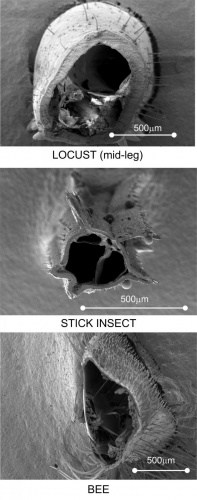Aircraft use these types of structures to reduce weight, but they need to be able to resist buckling to retain their strength and structural integrity. In medicine, thin tube-like structures have a range of applications, including in catheters.

“Thin-walled tubes are prone to failure by buckling,” said Professor David Taylor, one of the lead researchers.
“It is difficult to predict the loading conditions which cause buckling, especially for tubes of non-standard cross section. Think of a drinking straw. If you bend it, it will suddenly give.”
The scientists are examining how the legs of locusts, bees, stick insects and cockroaches buckle and bend when pressure is applied to them. These insects were chosen for the variety in their leg structures and the different ways in which they use their legs in their natural environments. Stick insects, for example have five longitudinal ridges running down their legs.
“We discovered that these ridges do not prevent buckling, but they do help the legs stay intact,” explained Taylor.
“In particular, they help resist a particular type of buckling called elastic buckling. This shows how material properties and geometry can interact in complex ways, which must be taken into account when designing thin-walled tubes.”
By comparison, bees have legs with a triangular cross section and a large flat area for the pollen basket. The team found that this area did not significantly affect the bending moment to failure, demonstrating that non-circular cross sections can be designed without compromising mechanical strength.
Elsewhere, the hollow legs of locusts and cockroaches were found to have near-circular cross sections that come close to breaking when the insects jump. The team hopes that through further testing, the research could lead to a range of biomimetic materials inspired by the insect leg structures.
“Essentially they get close to the limit,” said Taylor of the locust and cockroach legs.
“This is evolution operating close to the edge.”





AI-generated medical responses need monitoring, study finds
This would negate most of the benefit of using AI in the first place, rather like the Locomotive Act 1865 that required any self-propelled road...